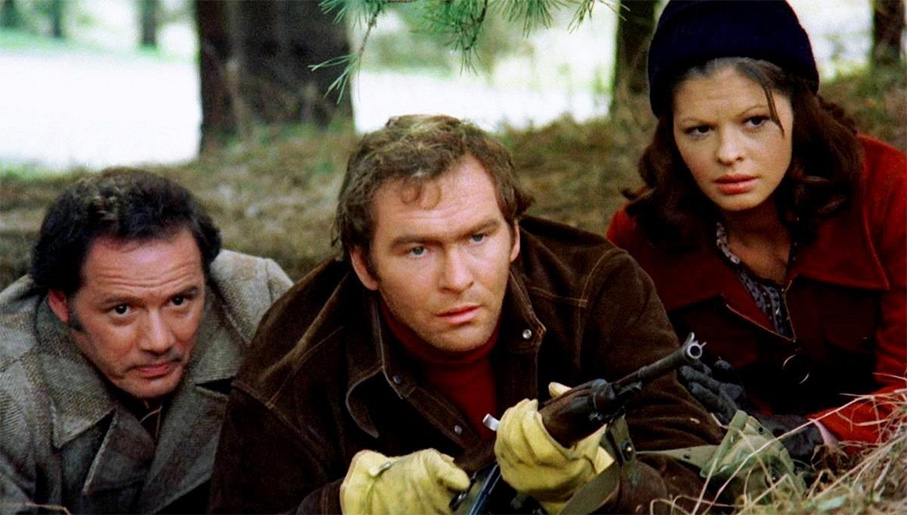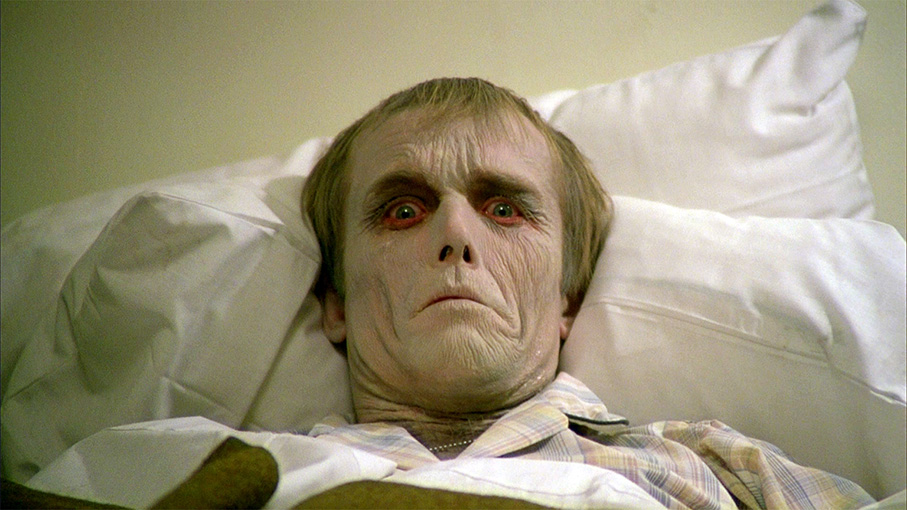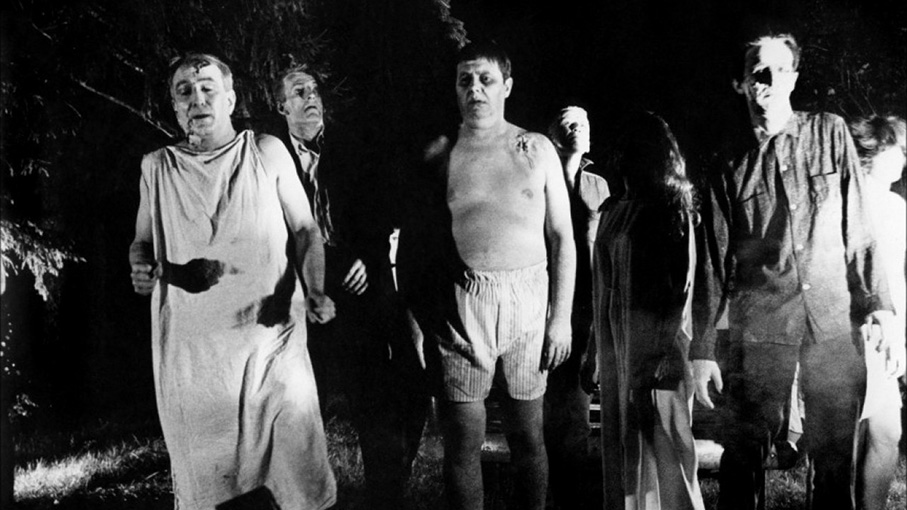|
If I had to choose a moment when the horror movie was brought screaming and kicking into the modern age, it would be 1st October, 1968. That was the day that George A. Romero’s seminal Night of the Living Dead was first screened in Pittsburgh, the Pennsylvanian city in which it was created and set. It’s preposterous, of course, to suggest that one film singlehandedly transformed the direction of an entire genre. After all, in the very same year Roman Polanski brought demonic horror into a contemporary urban setting with Rosemary’s Baby, paving the way for every such film to follow, The Exorcist included. Both were effectively independent films – Rosemary’s Baby was funded by the production company of former horror director and master showman William Castle – but it was Romero’s that would go on to define what was meant by the term ‘low-budget, independent horror movie’.
The differences between these two seminal films are important to note. Rosemary’s Baby was the work of a director who, while not yet internationally famous, already had a number of acclaimed films under his belt (including the superb psychological thriller, Repulsion). It had the pre-release prestige of being based on a best-selling novel by Ira Levin, had a budget of $2.3 million, high production values, a cast liberally peppered with recognisable faces, and was picked up for American distribution by none other than Paramount Pictures. Night of the Living Dead, on the other hand, was made by Romero and his associates on an estimated budget of $114,000, shot at weekends on monochrome stock, and featured a cast of complete unknowns that included the film’s producer and a number of locals recruited to play the living dead of the title. And while it took a while to find its audience, it’s nigh-on impossible to over-estimate its impact on the fortunes and development of the American horror movie and the horror genre in general. This is where the modern zombie movie was born, and where the rules for the plethora of similarly themed films that were later to follow in its wake were first set in stone. It wasn’t the first film to feature zombies, of course, but while the zombies in previous horror works tended to wander alone in the dark, their prime function to be eerie and unsettling for characters and audiences alike, Romero transformed them into a cannibalistic, instinct-driven mob and unleashed them en masse as an apocalyptic force against a small and imploding band of isolated survivors of an unspecified catastrophe. And he made it feel real, effectively shutting the door on the gothic period horrors on which Hammer had been trading and ruling the genre roost for over a decade. He also undercut the horror with a strong layer of social commentary. When I finally saw it for the first time in the late 1970s, it genuinely scared the living crap out of me.

Transforming the face of an entire genre with your very first feature and in the process creating one of the all-time great horror films would be enough for many filmmakers, but Romero was just getting started. In 1973, he delivered his second all-out horror work in the shape of The Crazies, a too-often overlooked gem that saw him expand on the apocalyptic feel of Night of the Living Dead with a tale of a town in which a military virus is spreading through the local population, driving them towards insanity and eventual death. Here Romero divided his focus between a struggling group of survivors trying to avoid being rounded up by the authorities, the increasingly strained efforts of the military to contain the virus, and the frustrated attempts of a scientific group to find a cure before the disease escapes its confines and infects the whole country. The film confirmed Romero’s talent for interweaving horror with social and political commentary and provided the strongest evidence yet that he was also one hell of an editor.
Five years later, he changed tack to deliver what he once claimed was his favourite of his films, an opinion I happen to share. Eschewing the apocalyptic tone of his previous horror works, Martin is a small-scale but beautifully devised and executed tale of a teenage boy who may either be an 86-year-old vampire, or a deeply troubled serial killer who simply believes he is one. Either way, his older cousin Cuda is convinced of the former and has been charged with watching over him, a task frustrated by Martin’s mockery of his beliefs and the ancient folklore that inspired them. I could prattle on for hours about the film’s content, depth and layers of subtext, but if you want to know more, then check out my reviews of the previous DVD releases – no sign of this one on UK Blu-ray yet. Here, Romero’s eye for scene construction, suggestive imagery and lightning-fast editing is at its keenest, and when I heard of Romero’s passing, this is the film that I went back to first.

What followed really did change everything. Building on key elements of both Night of the Living Dead and The Crazies, Romero’s next project was the film we’d all been secretly hoping he’d make. Depending on how you view it, Dawn of the Dead was either a follow-up to his auspicious debut or an indirect sequel, one in which those organised bands of zombie hunters actually failed to contain the spread of whatever it was that was reanimating the dead, which ran riot once it reached areas of high population. The opening scenes make it all too clear that society is in a state of total collapse and that the undead are starting to get the upper hand, and once again Romero chooses to focus on a group of determined survivors as they flee and search for safety and eventually make a home in a gargantuan shopping mall, where they fall prey to complacency triggered by the artificial comforts that their new home offers. What emerges as a searing satire on consumerism that also happens to be one of the very best and most exciting horror films of a decade that was frankly resplendent with great independent genre movies. And if Night of the Living Dead set out the rules of this new sub-genre, then Dawn of the Dead provided a ready-made template that has been slavishly followed by just about every zombie movie and TV series since, none of which is as thematically rich, as structurally sound or as much damned fun as Romero’s masterpiece.
And it didn’t end there. In 1982, Romero teamed up with literary genre giant Stephen King to create Creepshow, a glorious tribute to the EC horror comics with which the two men grew up, that over the course of five original stories and a pair of beguiling bookends, perfectly captures the style, content and appeal of their source material. He followed this with the third instalment in what was then his Dead Trilogy, Day of the Dead, which was neither a critical nor a box-office hit, but in subsequent years has built a sizeable cult following and is now particularly admired for its keenly focussed pessimism and its typically intriguing socio-political subtext.
Next up was Monkey Shines, a smartly developed thriller with a nail-chewingly tense finale that managed to make a frightening foe out of something as unlikely as a disabled man’s helper monkey. He shared directing duties with Italian maestro Dario Argento on the rather neat two-story horror anthology Two Evil Eyes, which is almost worth seeing for the cast alone. An adaptation of Stephen King’s The Dark Half has yet to find the sort of cult following that Day of the Dead now enjoys, and while Land of the Dead, the unexpected fourth entry into the Dead cycle, was greeted with widespread disappointment (then again, look how high Romero himself had set the bar), his found footage take on the genre, Diary of the Dead, saw his reputation partially restored. Opinion remains divided on his final film in the Dead cycle, Survival of the Dead, in part because by 2009 it was looking like one more zombie movie in a by then seriously overcrowded market.

But while Romero is remembered primarily for his horror works, he intermittently tried his hand at other genres with sometimes intriguing results. His second feature after Night of the Living Dead, for example, was the enjoyably light-hearted romantic drama, There’s Always Vanilla, which he followed with Season of the Witch, a horror-tinged work whose troubled production history may account for the mixed reviews it continues to attract. Rarely seen, both are soon to be released with The Crazies by Arrow in a three-film box set titled George Romero: Between Night and Dawn. Available for some time on Arrow dual format is Romero’s 1981 Knightriders, an enthralling drama about a group of jousting motorcyclists, who are led by a young Ed Harris and include in their number special makeup guru Tom Savini. It’s a terrific little film, and if you’ve never managed to catch it then I’d highly recommend giving it a look. I’m also genuinely surprised that so little mention is made of a documentary that Romero directed for TV back in 1974 that looked at the career of a man who was then one the country’s most popular sportsman. The title? O.J. Simpson: Juice on the Loose.
Early on, Romero would also make brief appearances in his own films. He’s the Washington reporter seen briefly in a TV report in Night of the Living Dead, can be heard as the voice of the beer commercial director in There’s Always Vanilla, is more clearly visible the frustrated TV director attempting to hold his studio together during the opening scenes of Dawn of the Dead, and in my favourite of his roles, is progressive priest Father Howard in Martin, a winningly naturalistic turn that nicely counterbalances Lincoln Maazel’s more theatrical performance as cousin Cuda. And just occasionally he’d guest for another director – blink twice and you’ll miss his uncredited cameo as an armed FBI officer in Jonathan Demme’s The Silence of the Lambs.
It should come as no surprise that Romero was also a devoted film fan. Some years ago I attended a lecture by Scorsese’s regular editor, Thelma Schoonmaker, and she told a story that I’ve since heard repeated elsewhere, including by Romero himself. One of Scorsese’s favourite films is Michael Powell and Emeric Pressburger’s Tales of Hoffman, and at one point he was repeatedly trying to borrow a film print from a library that had just one copy of this particular title, but every time it had been taken out by somebody else. Finally, the frustrated Scorsese demanded to know who it was whose relentless borrowing was preventing him from getting access to a movie he adored, and it turned out to be Romero, whose all-time favourite film this was. The two apparently became firm friends as a result. Just yesterday I learned that Romero passed away listening to the score from John Ford’s The Quiet Man, another one of his all-time favourites. A film devotee to the very end.

I can think of very few directors whose films impacted on me in my formative years as much as Romero’s did. I was scared witless by Night of the Living Dead, gripped and taught a whole string of lessons on film editing by The Crazies (including a key one on not crossing the line of action – I’ll talk more about this when I review Arrow’s upcoming Between Night to Dawn box set), was utterly blown away and ended up lying my arse off to a cinema manager to blag press materials for Dawn of the Dead, spent many a drunken evening with a long lost friend endless quoting dialogue from the wonderful Creepshow, and after watching Martin for the first time, I genuinely believed that a line had been drawn under the whole vampire genre. Because he was categorised as a horror director and because there was (and to a degree, still is) a great deal of critical snobbery when it comes to this particular genre, he was rarely discussed alongside the names of other widely celebrated late twentieth century filmmakers, yet every bit their equal he most definitely was. Look at the ground-breaking innovation of Night of the Living Dead, the ambition and genre-defining brilliance of Dawn of the Dead, the sometimes electrifying editing of Martin and The Crazies, and the sheer inventiveness, wit and audio-visual loveliness of Creepshow. And if I didn’t already love him enough for his work, the many interviews he gave showed him to be a man of great warmth and intelligence, while the commentary track on the original Anchor Bay DVD of Martin reveals that he was also a genuine political progressive.
If the term 'Living Dead' could be said in the real world to mean someone who lives on after their death through what they leave behind for us, then for George Andrew Romero, this really is the night, the dawn and the day of the living dead and will continue to be so for as long as his films are shown and watched and celebrated. Goodbye George. As a lifelong film fan and horror devotee, I’ll never forget what you did for me and all those like me.
|